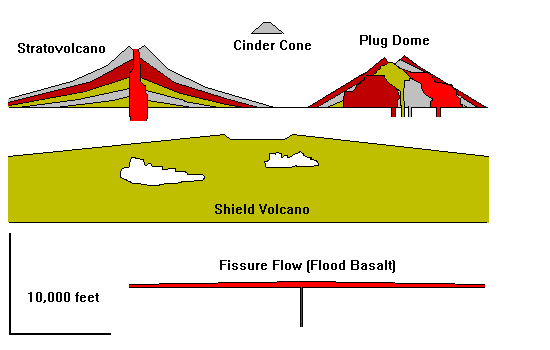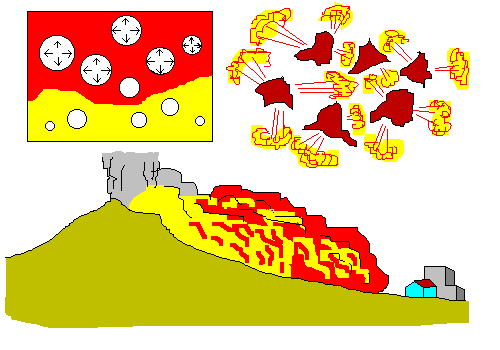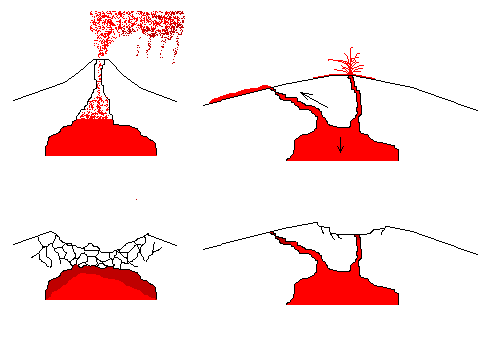Volcanoes
Steven Dutch, Professor Emeritus, Natural and Applied Sciences, University of Wisconsin - Green Bay
Igneous Rocks
Cool from the Molten State
- Volcanic -- Erupted on Surface
- Plutonic -- Solidify Within Earth
Large Grain Size ----> Slow Cooling
- Volcanic Rocks -- Fine Grained
- Plutonic Rocks -- Coarse Grained
Porphyritic Texture:
Large Crystals in Fine-grained Setting
- Slow Initial Cooling
- Rapid Final Cooling
Magma – molten rock beneath the surface Lava – molten rock on the surface
Where Does Magma Come From? Earth’s interior is hot (25 C/km near surface = 1000 C at 40 km) Pressure inhibits melting Mantle is solid Never far below melting point Volcanoes fed by small pockets 0-100 km deep Rising hot material may melt Water can lower melting point
Why Igneous Rock Classification Matters
Silica Content governs viscosity or resistance to flow, because silica tetrahedra link to form chains (polymerize), and the chains tangle around each other to impede flow. Fluid lavas allow gases to escape easily so silica content governs violence of eruptions. The principal volcanic rocks are
- Silica Poor (Basalt): Fluid lavas, generally little explosive activity
- Intermediate Lavas (Andesite): Pasty lavas, explosive eruptions common
- Silica-Rich Lavas (Rhyolite): Extremely viscous lava and explosive eruptions
Basalt (45-52% SiO2)
Slightly modified planetary raw material and therefore likely to be common on all planets. We know it occurs on the moon, Mars, Venus, and some asteroids. On earth basalt is derived directly from mantle and occurs in settings where magma comes straight from the mantle to the surface:
- Oceanic crust
- Hot Spots and Flood Basalts
- Oceanic volcanic arcs
- Early stage of continental volcanic arcs
- Rift zones with rapid spreading
Fluid lava with little explosive activity, builds shield volcanoes and cinder cones.
Andesite (52-66% SiO2)
Mixture of mantle material and continental crust and mostly restricted to continental volcanic chains. Pasty lava with significant explosive activity, builds stratovolcanoes.
Rhyolite (>66% SiO2)
Mostly remelted continental crust, occurs in settings where magma has a long time to react with continental crust:
- Late stage of continental volcanic arcs
- Slow-spreading Continental Rifts
- Long-lasting continental Hot Spots (Yellowstone)
- Catastrophic explosive activity common.
In addition to stratovolcanoes, rhyolite sometimes builds small obsidian domes. Occasionally there will be no volcano at all; instead the roof of a magma chamber simply collapses and huge volumes of ash, pumice and gas are vented suddenly. These are the most catastrophic of all eruptions. Some major examples:
- Yellowstone at least three times in the last 2 million years
- Long Valley Caldera, California 700,000 years ago
- Toba, Sumatra, Indonesia 70,000 years ago.
Some Igneous Rocks Are Named on Textural Criteria:
- Pumice
- Obsidian - Glass
- Tuff - Cemented Ash
- Breccia - Cemented Fragments
Types of Volcanoes

Classes of Eruption
Eruptions can be divided into two broad families
- Effusive eruptions erupt mostly lava (generally basalt) and have little explosive activity.
- Explosive eruptions are, well, explosive.
Explosivity Index
Proposed by Chris Newhall of the U.S. Geological Survey in 1982 as a means of quantifying the violence of eruptions. Volume refers only to material ejected explosively; Hawaiian and Icelandic eruptions may erupt vast volumes of lava but eject very little material explosively. Also, the index isn't really concerned with material that falls immediately around the vent. Hawaii is noted for spectacular fire fountains and the total material ejected may be quite large, pushing the upper end of explosivity 1, but the material mostly falls back around the vent.
Like the Richter Scale for earthquakes, the Volcanic Explosivity Index is logarithmic. Each step is about 10 times larger than the previous step.
| Index | Description | Plume Height | Volume of Ejecta | Classification | Example |
| 0 | non-explosive | < 100 m | 1000's m3 | Icelandic, Hawaiian | Kilauea |
| 1 | gentle | 100-1000 m | 10,000's m3 | Hawaiian, Strombolian | Stromboli |
| 2 | explosive | 1-5 km | 1,000,000's m3 | Strombolian, Vulcanian | Galeras, 1992 |
| 3 | severe | 3-15 km | 10,000,000's m3 | Vulcanian | Nevado Ruiz, 1985 |
| 4 | cataclysmic | 10-25 km | 100,000,000's m3 | Vulcanian, Plinian | Galunggung, 1982 |
| 5 | paroxysmal | >25 km | 1 km3 | Plinian | St. Helens, 1980 |
| 6 | colossal | >25 km | 10's km3 | Plinian, Ultra-Plinian | Krakatau, 1883 |
| 7 | super-colossal | >25 km | 100's km3 | Ultra-Plinian | Tambora, 1815 |
| 8 | mega-colossal | >25 km | 1,000's km3 | Ultra-Plinian | Yellowstone, 2 Ma |
Effusive Eruptions
- Icelandic
- Lava simply issues from fissures without building a volcano, though repeated activity may build shields. The greatest historic example was the Laki fissure flow of 1783, which killed about a fifth of the population of Iceland, mostly through crop and livestock destruction. Explosivity index 0. Note that merely being in Iceland doesn't make an Icelandic eruption; the Icelandic volcano Hekla has has some of the largest explosive eruptions in history.
- Hawaiian
- Basalt issues from long-lived central vents and builds shield volcanoes. Explosivity index 0-1.
Explosive Eruptions
- Phreatic
- Steam explosions caused when lava or magma comes in contact with water. Large events may blast out craters called maars. The few explosive eruptions on Hawaii have been phreatic. One in 1790 killed several members of a Hawaiian war party passing close to Kilauea. Another series occurred at Kilauea in 1924 and one person was killed by flying ejecta. Explosivity index 0-1 in most cases but maar eruptions may go as high as 3 or so.
- Strombolian
- Named for Stromboli, Italy, which has been popping mildly since Roman times and is nicknamed "lighthouse of the Mediterranean." Mild, long-lasting explosive activity confined to the immediate vent area. Typically associated with small stratovolcanoes (they don't erupt much material) and basalt or andesite lava. Explosivity index 1-2
- Vulcanian
- Named for Vulcano, Italy, from which we also get the term volcano. Typical explosive eruption, with a large eruption cloud but not much pyroclastic flows. Generally associated with andesite stratovolcanoes. Explosivity index 2-4
- Plinian
- Named for Pliny the Younger, who left a description of the eruption of Vesuvius in 79 A.D., and his uncle Pliny the Elder, who died in the eruption. Large eruption cloud, pyroclastic flows, and may collapse to create a caldera. Andesite or rhyolite stratovolcanoes. Mount Pelee, 1902 and Mount St. Helens, 1980 are examples. Explosivity index 4-6
- Caldera-Forming (Ultra-Plinian)
- Catastrophic eruption usually associated with rhyolite stratovolcanoes or magma chamber collapse. Extremely large volume of pyroclastic flows that may travel for long distances. Tambora, 1815, Krakatoa, 1883, Katmai, 1912 and Mount Pinatubo, 1991 were historic examples. Mount Mazama 7000 years ago and Thera (Santorini) about 1500 B.C. are other famous cases. Explosivity index 6-8
Products of Eruptions
- Lava Flows
- Pyroclastic Debris
- Bombs
- Lapilli
- Ash
- Mudflows
- Gases
- Steam
- Carbon Dioxide
- H2S
- SO2
- HCl
- HF
Environmental Hazards of Volcanoes
- Pollution
- SO2, HCl in Water
- Ash Falls
- Building Collapse
- Crop Destruction
- Mudflows (Lahars)
- Direct Damage
- Nevado Ruiz in Colombia, erupted in 1985. Melting of its snow cap unleashed a mudflow that buried the town of Armero, killing over 20,000 in the worst disaster of its type in history.
- The Tangiwai disaster in New Zealand in 1953 has all the ingredients of a movie script. It happened on Christmas Eve when a volcanic crater lake drained suddenly, taking out a railroad bridge. A few minutes later, a passenger train plunged over the collapsed bridge. A railroad employee ran up the tracks with a lantern to signal the train, and may have provided enough warning to allow the train to begin braking, so that only the engine and first six cars of the train fell into the flood. Of the 285 people on the train, 151 were killed. It is New Zealand's worst rail disaster.
- Floods
- Mudflows can dam rivers, impounding a lake. When the lake reaches the top of the poorly-consolidated dam, it can cut through the dam quickly and drain catastrophically.
- Mudflows can flow into a lake and displace all the water. When Mount St. Helens began erupting in 1980, reservoirs near the volcano were drawn down to avert this hazard.
- Mudflows can fill river valleys, leaving no place for normal river flow. The Army Corps of Engineers dredged valleys filled by Mount St. Helens in 1980 to deal with this problem. For several months, nearly all the dredges on the West Coast were cleaning up after Mount St. Helens.
- Direct Damage
- Lava Flows
- Loom large in popular thinking but are minor hazards. They generally move slowly and are predictable. In recent years several tourists have been killed in Hawaii venturing too close to lava flows, some by falls, some by inhalation of superheated steam. One tourist was burned badly by falling onto still-hot lava.
The only major fatalities directly due to lava flows in recent years are due to the volcano Nyiragongo in the Republic of the Congo (former Zaire). Nyiragongo presents the paradox of a steep-sided volcano that erupts very fluid lava, so that the lava flows can move at high speeds. Much of the time its crater is filled with a lava lake. On January 10, 1977 the lava lake drained catastrophically through fissures in the crater wall. The eruption happened in the middle of the night and overwhelmed several villages by surprise, killing 50-100 people. Some sources claim over 1000 fatalities but offer no evidence.
In January 2002, as if the Congo didn't have enough problems with a bloody civil war, Nyiragongo erupted and sent lava flows into the city of Goma (population 400,000) destroying half the city. This is easily the greatest damage to a city ever inflicted by lava flows. About 50-100 people were killed but there is no information on how many were killed directly by lava. For example, several dozen people were killed while looting an abandoned gas station when gasoline came into contact with lava and blew the station up. Others were killed by fires or building collapse rather than by the lava itself.
- Loom large in popular thinking but are minor hazards. They generally move slowly and are predictable. In recent years several tourists have been killed in Hawaii venturing too close to lava flows, some by falls, some by inhalation of superheated steam. One tourist was burned badly by falling onto still-hot lava.
- Falling Ejecta
- Blast (Mt. St. Helens, 1980)
- Pyroclastic Flow or Nuee Ardente
- The celebrated story of St. Pierre, Martinique in 1902 is a classic tale of an unknown type of disaster abetted by political ambition. Despite several months of volcanic activity at Mount Pelee, the governor refused to evacuate the city of St. Pierre. A pyroclastic flow swept over the town, killing 28,000 people. One survivor was a prisoner in the city jail, and thanks to the efforts of P.T. Barnum he was considered to be the only survivor for a long time. The story of a second survivor later came to light, and most texts say there were only two survivors. In reality there were other people found alive who later died of their injuries, and others outside the town who were caught in the flow and survived. The exact number of survivors is unlikely ever to be known but is almost certainly less than ten.
- Mount Lamington, New Guinea wasn't even recognized as a volcano when it began erupting in 1951. Three days later it unleashed a pyroclastic flow that killed 4,000 people.
- For a long time it was believed that the 79 A.D. eruption of Mount Vesuvius was fairly tame and the celebrated body casts found at Pompeii were of people who miscalculated how soon to evacuate. Studies since the 1980's have indicated that about 24 hours after the eruption began, the gas pressure in the volcano began to falter, allowing the eruption cloud to fall and roll down the mountain as pyroclastic flows. This phenomenon is called a collapsing Plinian cloud. The seaport of Herculaneum was hit first, Pompeii somewhat later. The eruption was much more violent than previously suspected. The ring of hills around Vesuvius, a caldera rim called Monte Somma, was formerly considered prehistoric, but many vulcanologists now regard it as a result of the 79 A.D. eruption. Roman wall paintings of Vesuvius show only a single cone. Vesuvius now rises well above Monte Somma but paintings from the 1500's and 1600's show the summit below Monte Somma.
- Gas
- Carbon dioxide is a common but little-noted hazard of eruptions. It can be a problem in confined spaces and low-lying areas. The 1973 eruption at Heimaey, Iceland resulted in toxic levels in many buildings. The only fatality during the eruption was a looter who was overcome by carbon dioxide while burglarizing a drug store for drugs.
- Lake Nyos is a crater lake in Cameroon, Africa. Gas is still seeping into the lake from the magma below and the lake is supercharged with carbon dioxide. Samples of water brought to the surface literally fizz like club soda. In 1986 the lake vented several cubic kilometers of carbon dioxide, which, being heavier than air, flowed down adjacent valleys and suffocated about 1800 people. The carbon dioxide displaced all the oxygen, plus pure carbon dioxide is highly toxic in its own right.
- Lake Kivu in the Congo and Rwanda is the largest gas-charged lake in the world, holding huge amounts of methane and carbon dioxide. Disaster planners are concerned that a volcanic eruption from nearby Nyiragongo, or under the lake itself, might trigger a large release of gas.
Greatest Earthquakes and Volcanic Eruptions
Pyroclastic Flow or Nuee Ardente (French: Fiery Cloud)

- Gas Expands as Lava Rises
- Lava Breaks up into Fragments Supported by Escaping Gas
- Cloud Flows Downhill at 60-100 M.p.h. Temperature about 1000 C. You will not outrun this.
Nuee Ardente is a more "classical" term, but seems to be in the process of being replaced by "pyroclastic flow." Pyroclastic flow deposits are typically called just that, or also "ash flows." Really large and thick deposits, especially those with evidence of violent eruption, are sometimes called ignimbrites from the Latin ignis, fire and imber, storm - a wonderfully descriptive term. Some pyroclastic flow deposits are so thick that the hot interior fuses together into a glassy mass. Such deposits are called welded tuffs.
Volcanoes with pyroclastic flow deposits in the vicinity should always be regarded as dangerous when they erupt. Once pyroclastic flows do begin erupting, the safest procedure is to estimate the greatest likely range of the flows, add a safety margin, and evacuate. The only way to survive an oncoming flow is to outrun it or evade it. Evasion might be possible if there's a quick route off to the side or uphill. Outrunning it is only possible if there's a good straight road, and then do not stop for anything - stop signs, police cars, red lights, animals, anything. Anything that does not outrun the flow will die.
How Calderas Form

Calderas form when volcanoes collapse. In some cases, violent explosive eruptions (left) can empty a magma chamber enough that the summit collapses. In other cases, magma may erupt on the flanks of a volcano or drain back to deeper levels, permitting the summit to subside (right). These caldera collapses are generally not violent.
In some cases, magma may be just a few kilometers below the surface. The roof of the magma chamber may cave in, uncorking the gas pressure and resulting in colossal pyroclastic flows and Ultra-Plinian eruptions with Explosivity Index 8. Yellowstone, Long Valley Caldera and Toba are important examples in the recent geologic past.
:Return to Environmental Geology Notes Index
:Return to Professor Dutch's home page
Created 3 Feb 2006, Last Update 15 January 2020